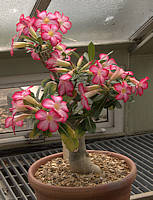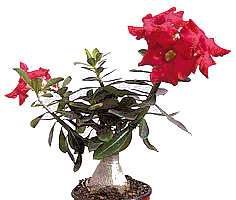Adenium Roemer & Schultes 1819Name: Greek aden = glandAdenium is a monotypic genus for a variable caudiciform species, Adenium obesum, with at least 6 recognized sub-species that may be encountered on labels as distinct species. The trunk and stems are spineless, unlike those of Pachypodium. As with other members of the Apocynaceae (Dogbane Family), the showy white, pink or red flowers have 5-fold symmetry. |

Adenium obesum Roemer & Schultes 1819
|
Cultivation
Adeniums are widely grown as tender houseplants and will not tolerate any frost or even cold conditions. A very free-draining potting mixture should be used and even then the plants should be watered carefully. Much work has been done to produce a variety of showy cultivars by hybridising between the different sub-species. Desirable varieties will probably not come true from seed so they are propagated by grafting as cuttings may be slow to produce the attractive bottle-shaped trunk.
|
  Families of Succulent Plants Families of Succulent Plants 
|
|
The Adenium PageDesert Rose |
Search this site

|
|
Advertisement |
|
| Succulent Plant Search EngineBotanical BookmarksBotanical GlossarySITEMAPEmail: webmaster |


